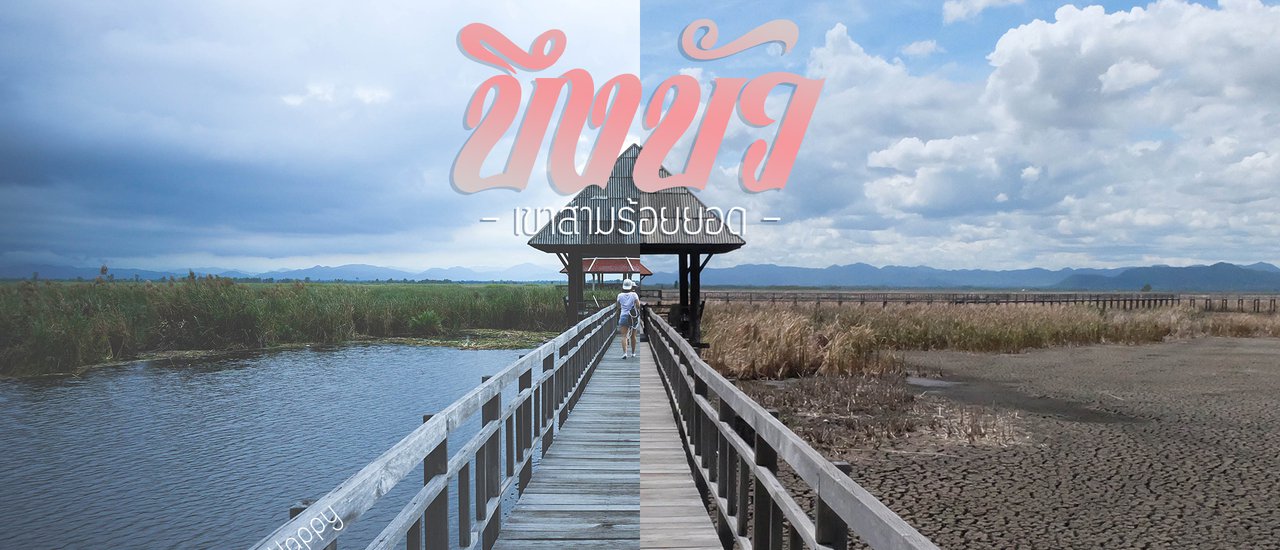Each season offers its own unique beauty, with the rainy and summer seasons being the most contrasting. Some locations are only popular during specific seasons due to their time-bound splendor. Who would have imagined that a location visited during the rainy season could be so different when revisited in the summer?
The lush image was taken in November 2015, while the arid image was taken in September 2016. These contrasting images provide a visual comparison of the landscape during periods of abundant water and extreme drought.

Bueng Bua Khao Sam Roi Yot is located in Khao Sam Roi Yot National Park, Prachuap Khiri Khan Province. It is a freshwater marsh covering an area of approximately 23,000 rai, making it the largest freshwater marsh within Thailand's national park system.
The entrance fee to Khao Sam Roi Yot National Park is 40 baht per person for Thai citizens and 30 baht for vehicles. This ticket grants access to all tourist attractions within the park, including Phraya Nakhon Cave. Therefore, if you visit Phraya Nakhon Cave on the same day, you will not need to pay an additional entrance fee. However, this offer is only valid on the same day of purchase.

This lotus pond offers stunning panoramic views due to its vast expanse and the majestic Three Hundred Peaks mountain range towering behind it. The serene atmosphere and tranquility make it an ideal spot for relaxation and reflection.
According to research, the lotus pond blooms from October to April, featuring various lotus species such as the sacred lotus, white lotus, and water lily.
Three consecutive years of severe drought have transformed this landscape. The once-abundant lotus flowers have perished, replaced by a vast expanse of reeds and grasses.


This elevated wooden walkway extends into the lagoon, allowing visitors to closely observe the ecosystem, various plant species, and aquatic animals. Visitors can admire water plants, birds, and fish throughout the 1,500-meter path. (I have visited twice but never completed the entire walk; I usually turn back after reaching the halfway point.)
Resting pavilions are available at intervals along the path, providing shelter from the sun and rain.


"Which do we prefer, drought or humidity?
Which do people prefer, wealth or poverty?"




The image of the lotus pond last month was desolate. Not only were there no lotus flowers to be found, but even the reeds stood withered and yellow in rows. The area that was once water had become a field, leaving only cracked earth stretching out as far as the eye could see.
The locals say it hasn't rained there at all. Hearing that, I wish the rain in the central region would fall there instead. In Bangkok, it rains every day, like clockwork, right when people get off work.



"Wait a moment. Soon, the rain will fall, and the water will rise. The reeds will come back to life, and the lotus pond will be reborn, offering us a refreshing sight of green, just like before."







**Getting to Bueng Bua**
From Bangkok, drive south on Rama II Road (Highway 35) and turn onto Phetkasem Road (Highway 4) at Wang Manao. Pass Phetchaburi and use the bypass to avoid Cha-am and Hua Hin. When you reach Pran Buri District, after passing Sam Roi Yot District, look for a left turn leading to Bueng Bua, Thung Sam Roi Yot. The entrance will be marked with a sign for the Chinese temple and Thung Sam Roi Yot. Drive approximately 8 km past the Chinese temple.
The drive takes about 3 hours. You can visit and return on the same day, or find accommodation and stay overnight by the sea.


The best time to visit is in the late afternoon, as the sunsets here are spectacular. We visited twice at midday, so we haven't had the chance to capture the sunset yet.


The second time I went was during the dry season. At that time, I didn't think to take pictures to compare. Otherwise, I would have looked at the camera angles I had taken before. I just took pictures randomly, so some of them are the same and some are not. I tried to choose similar angles to show the clear difference between the seasons.


Enjoy the photos.


The lack of water has discouraged tourists, and the bridge has deteriorated. To be honest, I wouldn't dare to lean on the railing.
As a wooden bridge, it is naturally subject to decay over time. Please walk with caution at this time.



The mountain behind remains lush no matter the season, always verdant like the first day.


The top picture shows two people walking. The bottom picture cuts back to a desolate, arid, and unpopulated scene.
The two pictures are completely opposite.

Rain is always better than drought.


The sight of the cracked earth evokes a profound sense of sorrow that is difficult to express.


While the green grass provided a scenic backdrop for photographs, the absence of water in the pond left me with nothing to capture.


Deep blue sky, green mountains, brown lotus pond.




The picture below shows rain falling in the distance.



Follow our small page for fun and relaxing travel content. (Come and take a look!)
"The writer is happy, and the readers are happy too."
SandyHappy
Friday, September 27, 2024 10:37 AM

















